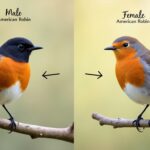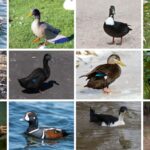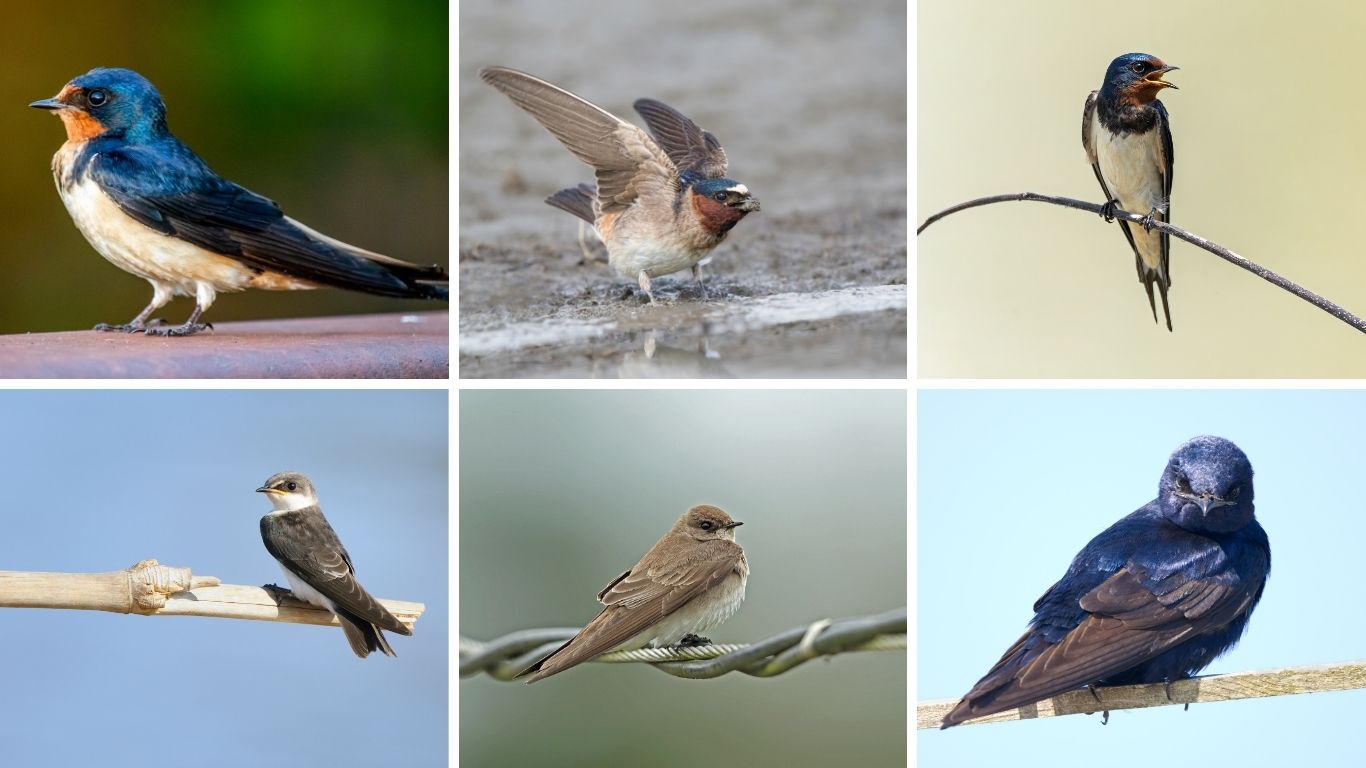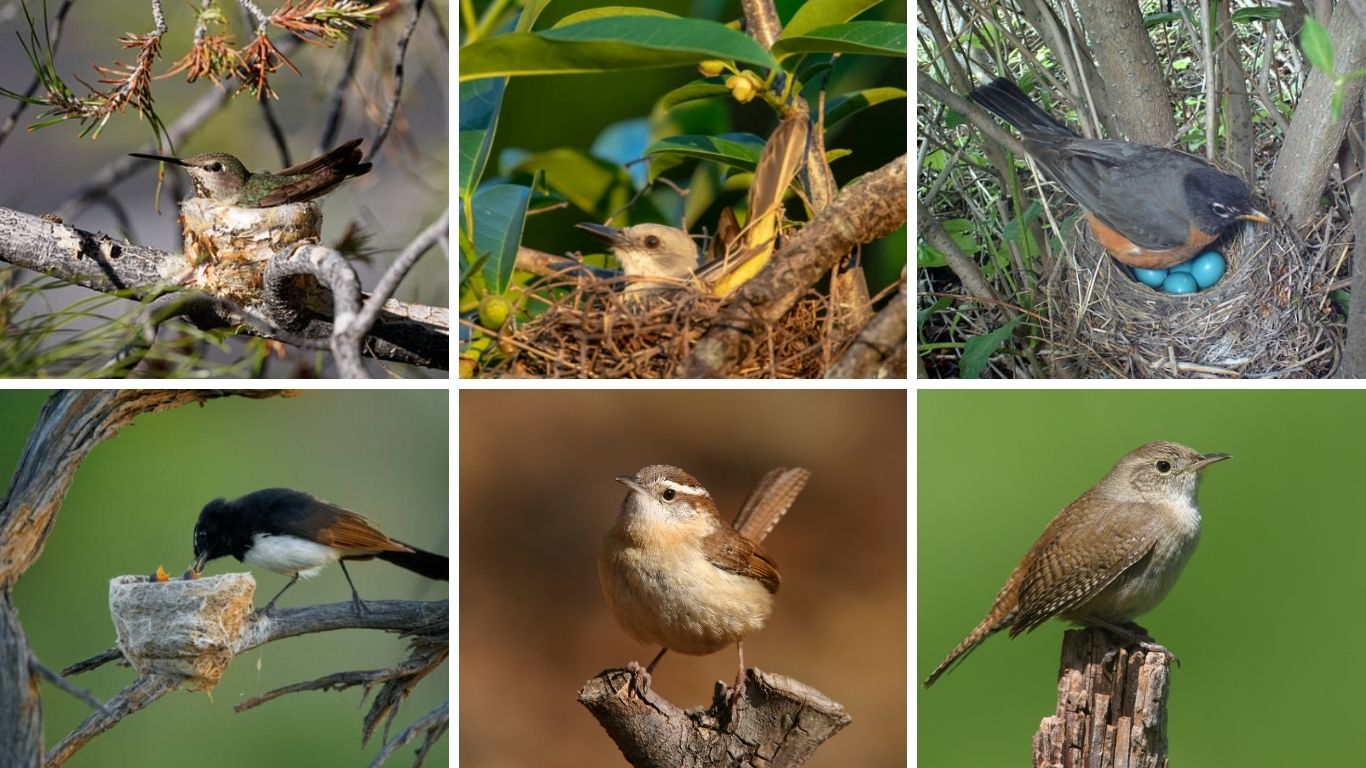Many bird species rely exclusively on insects for their survival, playing a vital role in natural pest control and ecosystem balance. These insectivorous birds are found in forests, fields, wetlands, and even urban areas—constantly hunting flies, beetles, mosquitoes, and more. From acrobatic flycatchers to swift-flying swallows and stealthy warblers, each bird on this list is finely adapted to catching and consuming insects as their primary food source.
1. Black Phoebe

The Black Phoebe is a sleek, insect-eating bird commonly found near water sources. Recognized by its dark plumage and tail-wagging behavior, this flycatcher is often seen perched on low branches or fences before darting out to snatch insects mid-air. Its constant presence near streams, lakes, and even backyard fountains makes it a familiar sight in parts of the western United States and Central America.
Identification
- Small to medium-sized songbird
- Mostly black body with a white belly
- Upright posture and frequent tail dipping
- Slight crest and thin black bill
Habitat
Black Phoebes prefer habitats near water, including rivers, lakes, ponds, and fountains. They are commonly found in urban parks, coastal cliffs, and farmlands with nearby water sources.
Diet
Their diet consists almost entirely of flying insects such as flies, mosquitoes, wasps, beetles, and dragonflies. Occasionally, they may consume small aquatic creatures.
Behaviors
Black Phoebes use a “sit-and-wait” hunting strategy—perching low and scanning for prey. They sally out to catch insects in the air, then return to the same or nearby perch. They are known for their repetitive tail-pumping motion and distinctive “tsip” call.
2. Eastern Phoebe

The Eastern Phoebe is a quiet yet widespread insect-eating bird in eastern North America. It is known for its tail-wagging habit and soft “fee-bee” call. Often nesting on ledges or under bridges, this bird is commonly seen flitting from perch to perch in search of flying insects.
Identification
- Plain grayish-brown upperparts
- White underparts
- Dark head and short black bill
- Slight crest and constant tail wagging
Habitat
Eastern Phoebes thrive near open woodlands, farmland edges, streams, and human structures like barns and culverts.
Diet
Primarily feeds on insects such as wasps, flies, beetles, and grasshoppers. Occasionally supplements diet with small berries in colder months.
Behaviors
They are solitary flycatchers and often return to the same nesting site year after year. They hunt by sallying from low perches and snapping insects mid-flight.
3. Scissor-tailed Flycatcher

Known for its dramatic tail and acrobatic flight, the Scissor-tailed Flycatcher is a striking bird of the southern plains. Its long forked tail and pale plumage make it unmistakable in open country.
Identification
- Pale gray body with salmon-pink sides
- Extremely long, forked tail
- Dark wings with white edges
- Slender body and pointed bill
Habitat
Favors open areas like grasslands, prairies, ranchlands, and roadside fences. Often seen in southern U.S. states and parts of Central America.
Diet
Consumes mainly flying insects such as grasshoppers, beetles, wasps, and bees. Occasionally eats small fruits.
Behaviors
Perches on utility wires or fences to hunt. Known for agile mid-air twists while catching prey. Displays aerial courtship with long-tailed gliding dives.
4. Say’s Phoebe

Say’s Phoebe is a soft-colored flycatcher often seen in dry, open country. It is one of the earliest migratory songbirds to return to its breeding grounds, often appearing before spring fully arrives.
Identification
- Brownish-gray upperparts
- Pale orange-buff belly
- Slight black tail
- Thin dark bill and upright stance
Habitat
Commonly found in arid grasslands, canyons, farmlands, and desert scrub throughout the western U.S. and Mexico.
Diet
Feeds almost exclusively on insects like flies, beetles, wasps, and moths, caught on the wing or from the ground.
Behaviors
Perches on fence posts or rocks, flying out to snatch prey before returning. Often nests on ledges of buildings or cliffs, showing tolerance for human presence.
5. Vermilion Flycatcher

The Vermilion Flycatcher is a small but vividly colored bird, especially the male with its brilliant red and black plumage. Found mostly in the southwestern U.S. and parts of Central and South America, this bird brings a splash of color to dry, open landscapes.
Identification
- Males: bright red body with black wings and back
- Females: pale gray with salmon-colored belly
- Small, rounded head and slender bill
- Compact size with a slightly notched tail
Habitat
Prefers open woodlands, desert scrub, agricultural fields, and riverbanks. Often seen perching on fences, wires, and shrubs in arid regions.
Diet
Feeds almost entirely on insects such as flies, beetles, grasshoppers, and moths. Occasionally consumes spiders and other small invertebrates.
Behaviors
Often seen sallying out from a perch to snatch insects mid-air. Males perform short hovering flights during courtship. Despite their tropical appearance, they are hardy and tolerate dry, hot environments.
6. Acadian Flycatcher

A small, elusive bird of mature deciduous forests in eastern North America, the Acadian Flycatcher is best identified by its explosive “peet-sa” song. It’s one of the more challenging flycatchers to spot due to its preference for dense, shaded woods.
Identification
- Olive-green upperparts
- Pale underparts with slight yellow wash
- Short tail and relatively long wings
- Distinctive eye ring and broad bill
Habitat
Inhabits shady, mature forests near streams and ravines. Avoids open areas and prefers deep forest interiors, especially near water.
Diet
Feeds primarily on insects such as ants, bees, wasps, beetles, and flies. Occasionally picks insects from foliage in addition to aerial hunting.
Behaviors
Perches silently in the understory before darting out to catch flying insects. Nests are usually built in forked branches overhanging water. Males sing persistently throughout the breeding season.
7. Willow Flycatcher

A member of the tricky-to-identify Empidonax group, the Willow Flycatcher is best distinguished by its harsh “fitz-bew” song. It’s a summer resident of wet thickets across much of the U.S. and migrates to Central and South America for the winter.
Identification
- Dull olive-gray upperparts
- Light underparts with a pale throat
- Slight eye ring and short tail
- Broad, flat bill with yellowish lower mandible
Habitat
Favors shrubby areas near water such as willow thickets, stream banks, wet meadows, and riparian zones.
Diet
Eats flying insects including flies, beetles, moths, and caterpillars. Sometimes gleans insects from leaves or branches.
Behaviors
Actively hunts from low perches, launching quick flights to catch insects. Sings often during the breeding season. Builds cup-shaped nests in dense vegetation, often hidden in shrubs.
8. Least Flycatcher

The Least Flycatcher is the smallest member of the Empidonax flycatchers. Though visually similar to its relatives, it stands out with its sharp, repeated “che-bek” call. This bird breeds across northern and eastern forests of North America.
Identification
- Small size and compact shape
- Olive-gray upperparts and whitish underparts
- Bold white eye ring
- Short wings with distinct wing bars
Habitat
Breeds in deciduous and mixed forests, especially edges and clearings. Found in groves, orchards, and woodlots during migration.
Diet
Feeds mostly on flying insects—midges, mosquitoes, beetles, and moths. Occasionally consumes small caterpillars and spiders.
Behaviors
Perches quietly, flicking wings and tail before darting out to grab insects. Often returns to the same perch. Aggressive toward intruders during nesting season.
9. Great Crested Flycatcher

This bold and vocal flycatcher inhabits wooded habitats across much of eastern North America. Its distinctive calls and bright colors make it easier to spot than many of its quieter relatives.
Identification
- Olive-brown upperparts and lemon-yellow belly
- Gray throat and chest
- Reddish tail and wing feathers
- Large bill and crest
Habitat
Prefers open woodlands, forest edges, and clearings. Frequently nests in tree cavities in both rural and suburban areas.
Diet
Feeds primarily on flying insects—beetles, dragonflies, wasps, and grasshoppers. Occasionally eats small fruits and berries, especially in late summer.
Behaviors
Often perches high in the canopy, swooping out to catch prey in the air. Known to line nests with shed snake skins or plastic. Loud “wheep” calls echo through forests during breeding season.
10. Ash-throated Flycatcher

A dry-country cousin of the Great Crested Flycatcher, the Ash-throated Flycatcher is a common sight in the deserts and scrublands of the American West. Its soft calls and pale plumage distinguish it in its arid habitat.
Identification
- Pale gray throat and chest
- Light yellow belly and pale olive back
- Rusty edges on tail and wings
- Slim body and pointed bill
Habitat
Commonly found in dry brushlands, desert scrub, pinyon-juniper woodlands, and canyons. Nests in tree cavities or nest boxes.
Diet
Feeds mainly on insects—grasshoppers, beetles, ants, and flies. Occasionally includes berries and small fruits.
Behaviors
Perches quietly on exposed branches, scanning for prey. Flies out to snatch insects in the air or from the ground. Uses abandoned woodpecker holes or cavities for nesting.
11. Eastern Kingbird

The Eastern Kingbird is a bold and aggressive insectivore often seen chasing much larger birds away from its territory. It’s a familiar sight across open fields, farmlands, and grasslands in eastern North America during the summer.
Identification
- Slate-black head and back
- White underparts
- White band at the tip of the tail
- Sturdy body with a broad bill
Habitat
Prefers open areas with scattered trees or fences, such as grasslands, orchards, and riverbanks. Often seen perched on wires or fences.
Diet
Feeds almost entirely on flying insects—bees, wasps, beetles, grasshoppers, and moths. Occasionally eats berries and fruits late in the season.
Behaviors
Uses aerial foraging to catch insects in mid-flight. Aggressively defends nests and territories, often attacking hawks or crows. Their sharp “zeer” call is common during the breeding season.
12. Western Kingbird

The Western Kingbird is a bold, yellow-bellied flycatcher of open western landscapes. Like its eastern counterpart, it is known for its fearless nature and energetic insect-chasing flights.
Identification
- Pale gray head and chest
- Bright yellow belly
- Black tail with white outer edges
- Upright posture with strong bill
Habitat
Found in grasslands, deserts, farms, roadsides, and suburban areas. Often nests on utility poles, fences, or buildings.
Diet
Feeds primarily on insects—beetles, wasps, flies, and grasshoppers. Occasionally supplements diet with fruits in late summer.
Behaviors
Frequently perches on wires or fences and sallies out for flying insects. Very territorial—chases intruders including larger birds. Performs fluttering courtship flights with distinctive calls.
13. Olive-sided Flycatcher

The Olive-sided Flycatcher is a long-distance migrant known for its loud “quick-three-beers!” song and preference for tall perches in coniferous forests. Though declining in numbers, it’s still a powerful presence in northern and western woodlands.
Identification
- Dark olive-gray back and flanks
- White center of the chest and belly
- Short tail and big-headed appearance
- Long bill with a hooked tip
Habitat
Prefers open coniferous forests, forest edges, and burned or logged areas with tall snags. Common in mountainous and boreal regions.
Diet
Feeds exclusively on flying insects—bees, wasps, flies, and beetles. Hunts entirely in the air, often far from vegetation.
Behaviors
Perches high atop dead trees or snags. Launches swift, long flights to snatch insects. Known for its sharp, repetitive call and persistent singing during breeding. Often returns to the same territory year after year.
14. Barn Swallow

The Barn Swallow is one of the most widespread and easily recognized insect-eating birds, known for its graceful flight and long, deeply forked tail. It nests near humans and is often seen swooping low over fields and water.
Identification
- Shiny blue back and head
- Cinnamon-colored throat and underparts
- Long, forked tail with white spots
- Streamlined body and pointed wings
Habitat
Found in open habitats like fields, pastures, lakeshores, and near human structures such as barns, bridges, and sheds.
Diet
Feeds exclusively on flying insects—mosquitoes, flies, beetles, wasps, and other airborne bugs. Captures prey while in continuous flight.
Behaviors
Highly aerial; spends most of its time flying in pursuit of insects. Nests are mud cups often built under eaves or inside barns. Social birds, often nesting in loose colonies.
15. Tree Swallow

The Tree Swallow is a sleek, shimmering blue insectivore commonly seen over lakes, marshes, and fields. It is a cavity nester and readily uses nest boxes, making it a favorite among birdwatchers and conservationists.
Identification
- Iridescent blue-green back
- Clean white underparts
- Small, sharp bill
- Slightly forked tail
Habitat
Prefers open areas near water, including wetlands, meadows, and ponds. Nests in tree cavities or artificial nest boxes.
Diet
Feeds mainly on flying insects such as flies, midges, and mosquitoes. Will occasionally eat small aquatic insects or berries in late summer.
Behaviors
Flies fast and gracefully while catching insects in mid-air. Nests in colonies and defends nest cavities aggressively. Migrates in large flocks and roosts communally.
16. Cliff Swallow

Cliff Swallows are colonial nesters and known for building gourd-shaped mud nests under bridges, cliffs, and buildings. These swallows are highly social and feed entirely on flying insects.
Identification
- Dark blue back and pale, buffy underparts
- White forehead and rusty-red throat
- Squared tail and broad, pointed wings
- Compact build
Habitat
Found in open areas near water, cliffs, and urban structures. Nests in large colonies on man-made or natural overhangs.
Diet
Feeds exclusively on flying insects including gnats, flies, beetles, and winged ants. Hunts during long flights high in the air.
Behaviors
Extremely social—feeds, migrates, and nests in large groups. Builds mud nests side-by-side in colonies. Capable of long-distance migration and highly adapted to human-altered environments.
17. Northern Rough-winged Swallow

The Northern Rough-winged Swallow is a quiet, brown-colored insectivore that often flies low over water or open fields in search of prey. Despite its drab appearance, it plays an essential role in controlling insect populations.
Identification
- Plain brown upperparts and pale grayish underparts
- Slightly notched tail
- Small, slender body with long wings
- Rough outer wing feathers (not easily visible in the field)
Habitat
Favors open areas near water—rivers, streams, lakeshores, and quarries. Often nests in banks, crevices, or even drainage pipes.
Diet
Feeds entirely on flying insects like flies, beetles, ants, and wasps. Catches prey while gliding or swooping in open airspace.
Behaviors
Flies with slow, purposeful wingbeats compared to other swallows. Nests in burrows, cliffs, or urban drainage holes. Less social than other swallows; often seen foraging alone or in small groups.
18. Purple Martin

The Purple Martin is North America’s largest swallow and a beloved insect-eater known for its glossy plumage and dependence on human-provided housing in many areas.
Identification
- Males: glossy purple-black all over
- Females: grayish belly with darker back and head
- Broad chest, tapered wings, and forked tail
- Large, agile flyer
Habitat
Breeds in open areas near water, fields, and residential backyards. Relies heavily on man-made martin houses and gourds for nesting.
Diet
Feeds entirely on flying insects—dragonflies, beetles, wasps, flies, and moths. Eats hundreds of insects per day.
Behaviors
Highly aerial; forages on the wing at high altitudes. Forms large breeding colonies. Known for vocal chatter and strong site fidelity to nest colonies year after year.
19. Common Nighthawk

Despite its name, the Common Nighthawk is not a true hawk but a crepuscular bird that feeds almost exclusively on insects during dusk and dawn flights. Its erratic, silent flight makes it easily identifiable in open skies.
Identification
- Long, slender wings with a bold white bar
- Cryptic gray-brown mottled body
- Slightly forked tail and small beak
- Large eyes adapted for low light
Habitat
Found in open habitats—fields, urban rooftops, grasslands, and deserts. Nests on flat gravel rooftops, bare ground, or sandy areas.
Diet
Feeds entirely on flying insects like moths, beetles, ants, and mosquitoes. Captures prey on the wing at dusk or dawn.
Behaviors
Forages during twilight hours with erratic, looping flight. Roosts on the ground or flat surfaces during the day. Makes a deep “boom” sound with its wings during courtship dives.
20. Chuck-will’s-widow

The Chuck-will’s-widow is a nocturnal insect-eating bird known for its mellow, repetitive call on warm summer nights. With excellent camouflage, it often goes unseen during the day while resting on the forest floor or branches.
Identification
- Mottled brown, gray, and black plumage
- Large head and tiny bill with a wide mouth
- Long tail and rounded wings
- Big dark eyes for night vision
Habitat
Found in dry woodlands, pine forests, and scrubby areas across the southeastern United States. Prefers areas with open understory for ground roosting.
Diet
Feeds almost entirely on large flying insects—moths, beetles, grasshoppers, and cicadas. Hunts at dusk and dawn.
Behaviors
Catches insects in flight using a wide-gaping mouth. Roosts on the ground or horizontal limbs. Highly vocal during breeding season with a haunting “chuck-will’s-widow” call.
21. Eastern Wood-Pewee

The Eastern Wood-Pewee is a small flycatcher of eastern North American forests. Its plaintive, whistled “pee-a-wee” song often gives away its presence before it’s seen.
Identification
- Gray-olive upperparts
- Pale underparts with a washed-yellow tint
- Two whitish wing bars
- Slim body with upright posture
Habitat
Prefers open woodlands, forest clearings, and woodland edges. Found in both deciduous and mixed forests.
Diet
Feeds exclusively on flying insects—flies, beetles, ants, and moths. Catches prey mid-air from a perch.
Behaviors
Uses a sit-and-wait strategy from mid-level perches. Often returns to the same perch after quick flights. Known for persistent, clear vocalizations during the breeding season.
22. Western Wood-Pewee

Similar to its eastern cousin, the Western Wood-Pewee lives in open western forests and is often heard singing a buzzy, descending “tsee-tsee-peeer.”
Identification
- Grayish-brown upperparts and light gray underparts
- No bold eye ring
- Two pale wing bars
- Thin, pointed bill with yellowish lower mandible
Habitat
Occupies open woodlands, forest edges, burned areas, and mountain forests throughout the western U.S. and Canada.
Diet
Feeds almost exclusively on flying insects—bees, wasps, flies, and beetles. Captures prey in quick aerial pursuits.
Behaviors
Forages by sallying from exposed perches. Flutters to catch insects and may hover briefly. Males sing persistently during breeding season. Migrates to South America for winter.
23. Blue-gray Gnatcatcher

The Blue-gray Gnatcatcher is a tiny, energetic songbird often compared to a miniature mockingbird. It flits actively through treetops in search of small insects, constantly twitching its long tail.
Identification
- Blue-gray upperparts and white underparts
- Long, black-edged white tail
- Thin, straight black bill
- Males show a faint black “eyebrow” in breeding season
Habitat
Favors open woodlands, forest edges, scrublands, and thickets. Found across much of the U.S. during breeding season.
Diet
Feeds almost exclusively on tiny insects and spiders, including gnats, aphids, beetles, and caterpillars.
Behaviors
Moves quickly through foliage, gleaning insects and sometimes catching them in flight. Flicks and fans its tail to startle prey. Builds a small, camouflaged nest high in trees using spiderwebs and lichen.
24. Black-and-white Warbler

The Black-and-white Warbler is unique among warblers for its nuthatch-like behavior, creeping along tree trunks and branches while searching for insects.
Identification
- Bold black and white striped plumage
- Thin, slightly curved bill
- Short tail and strong legs
- Males have more intense black streaks than females
Habitat
Inhabits mature forests, especially with deciduous trees. Common in woodlands during spring and fall migration.
Diet
Feeds on insects and spiders hiding in bark—ants, beetles, caterpillars, and moths. Rarely eats anything else.
Behaviors
Crawls up and down trunks and limbs like a woodpecker. Uses sharp bill to probe into bark crevices. Sings a high-pitched, repetitive song often described as “wee-see, wee-see.”
25. American Redstart

The American Redstart is a lively and colorful warbler known for its bright flashes of orange or yellow and its habit of fanning its tail while foraging.
Identification
- Males: black with bright orange patches on wings, tail, and sides
- Females: gray with yellow patches
- Medium-length tail constantly flicked open and closed
- Slim build with a small pointed bill
Habitat
Breeds in deciduous forests, thickets, and second-growth woodlands. Winters in tropical forests and gardens.
Diet
Feeds primarily on flying insects—midges, flies, moths, and small beetles. Also gleans caterpillars and spiders from leaves.
Behaviors
Active and acrobatic; fans its tail and wings to flush insects from foliage. Often forages in the mid to upper canopy. Frequently sings a whistled, variable song during the breeding season.
26. Northern Parula

The Northern Parula is a small, colorful warbler that nests high in trees and fills spring forests with its buzzy trill. Despite its small size, it is a highly active insect hunter.
Identification
- Blue-gray upperparts with a greenish patch on the back
- Yellow throat and chest with a dark chest band
- White eye arcs and wing bars
- Small, rounded body with a thin bill
Habitat
Prefers mature, moist forests with hanging mosses or lichens. Found in eastern North America, especially near rivers and swamps.
Diet
Eats mostly insects and spiders—caterpillars, beetles, flies, and ants. Also consumes small moths and wasps.
Behaviors
Forages by picking insects from foliage or flying short distances to catch prey mid-air. Known for rapid, buzzy trills. Builds a hanging nest usually concealed in Spanish moss or beard lichen.
27. Hooded Warbler

The Hooded Warbler is a striking forest warbler with bold markings and a clear, ringing song. It is a stealthy insect-hunter, staying low in dense underbrush.
Identification
- Males: bright yellow face with a black hood and throat
- Females: yellow face with faint hood or none
- Olive-green back and yellow underparts
- Large black eyes and sharp, pointed bill
Habitat
Inhabits dense understory of moist deciduous forests, especially in the southeastern U.S.
Diet
Feeds exclusively on insects—flies, beetles, caterpillars, spiders, and moths. Rarely eats seeds or fruit.
Behaviors
Stays low in thickets, flicking its tail to flush insects. Catches prey by gleaning from leaves or in quick aerial flights. Males sing loud, melodic whistles to defend territory and attract mates.
28. Red-eyed Vireo

The Red-eyed Vireo is one of the most persistent singers of the forest canopy, often calling from dawn to dusk during the breeding season. It searches leaves methodically for insects.
Identification
- Olive-green upperparts and whitish underparts
- Gray crown with white eyebrow and black border
- Red eyes (in adults)
- Sturdy body with a thick, slightly hooked bill
Habitat
Prefers mature deciduous forests, often staying high in the canopy. Found across eastern and central North America.
Diet
Feeds primarily on insects such as caterpillars, beetles, and leafhoppers. Will also eat spiders and occasionally berries in fall.
Behaviors
Moves slowly and deliberately through foliage, probing under leaves for insects. Sings a short, rhythmic song almost continuously in breeding season. Builds a deep cup nest suspended from a tree branch.
29. Warbling Vireo

The Warbling Vireo is a plain but melodic songbird commonly heard in wooded areas during spring and summer. Though its appearance is modest, its sweet, warbling song helps it stand out among forest birds.
Identification
- Grayish-olive upperparts and pale whitish underparts
- Faint white eyebrow
- Small, stout body with a slightly hooked bill
- Lacks strong markings, very plain overall
Habitat
Inhabits open woodlands, riparian forests, parks, and suburban areas with scattered trees. Often found near streams and rivers.
Diet
Feeds mainly on insects—caterpillars, beetles, aphids, and leafhoppers. Also eats spiders and occasionally berries during migration.
Behaviors
Gleans insects from foliage, sometimes hovers briefly to snatch prey. Moves slowly through treetops. Males sing cheerful, fluid songs during breeding season. Builds hanging cup nests high in trees.
30. Ruby-crowned Kinglet

The Ruby-crowned Kinglet is a tiny, restless insectivore often flitting rapidly through shrubs and trees. Despite its size, it has an energetic presence and surprisingly loud voice.
Identification
- Olive-green upperparts and pale underparts
- Eye ring and two white wing bars
- Males show a hidden red crown patch when excited
- Constantly flicks wings while foraging
Habitat
Found in coniferous and mixed forests during breeding; uses a wide variety of wooded habitats during migration and winter.
Diet
Feeds almost entirely on small insects—aphids, gnats, caterpillars, beetles, and insect eggs. Also eats spiders and a few berries in colder months.
Behaviors
Moves quickly and flicks its wings constantly. Gleans insects from leaves and branches, sometimes hovering. Males sing a loud, complex song especially during spring. Nests are built in hanging branches, often well-concealed.











